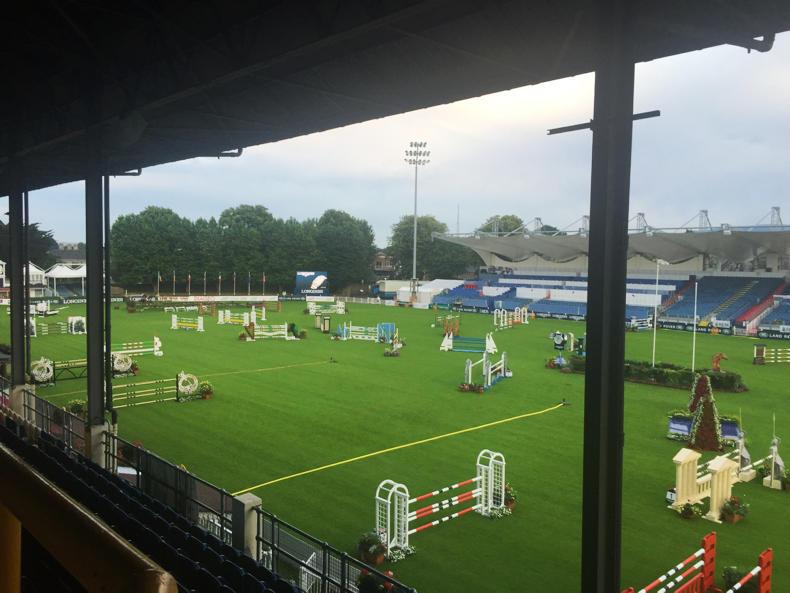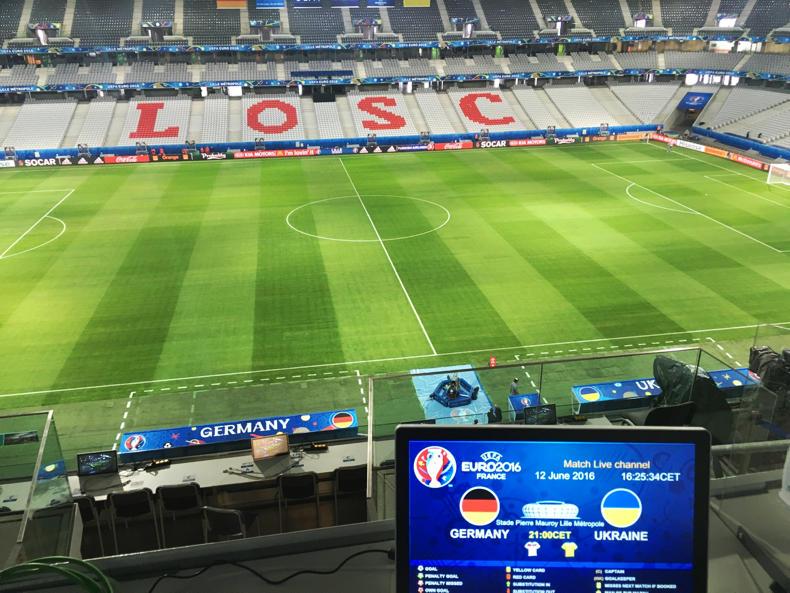It’s the final of the World Cup, national anthems are being sung proudly, the teams are focused and determined, the crowd is pumped and the stadium looks only magical.

Long before the first athlete arrives on the pitch though, Richard Hayden was out inspecting the pitch, ensuring it was up to his highest standards.
Ag science graduate and Kilkenny native Richard began his career as a tractor driver and now he runs one of the most successful sport surface companies in the world, Hayden Turfcare.
“Hayden Turfcare was founded in 2016, I had been working in the industry 14 years at that point and wanted to start my own business. I started off as a tractor driver and worked my way up,” says Richard.
“We provide knowledge and expertise in the development of sport pitches, racecourses, show jumping arenas, anything to do with surfaces and sport. Our main business is grass-based sports and we have worked on everything from the World Cup to the RDS Horse Show and the GAA pitches.”
Importance of soil
Before work commences on any project Richard studies the soil.
“The first thing we do is excavate soil pits and see what we’re working with. The quality of the soil will determine the success of the project, our approach, the time of year we’re going to work the soil and budget, it determines everything.
“I’ve gained a huge appreciation for soil over the years; I’m passionate about soil and the protection of soil. No differently than agriculture, the tools of our trade are being taken away and we’re having to manage things more organically. On that basis, soil is becoming so important.”

Richard Hayden horse riding.\ Dawn Walmsley.
Soil is the foundation which everything is built upon and has a huge impact on GAA pitches in particular.
“In a stadium we’re generally building with materials such as sand so it’s a bit different, but with GAA pitches we’re dealing with natural soils. A local parish GAA pitch is a more technical, challenging project for me than a stadium. A stadium is pretty straightforward, you’re dealing with sand, engineering and relatively set standards. With a local GAA pitch, we’re starting from scratch; we’re looking at soil and ground conditions and there is no template to use.
“I have done three World Cups and three Euros, I’m the appointed consultant for Russia 2020; they’re a challenge but a different type of challenge.”
So what kind of qualities does Richard look for in soil?
“The greater the sand content a soil has, the more likely it will drain so I’m looking for the physical characteristics-sand, silt, and clay content.”
Richard’s biggest project this year to date, is the Curragh Racecourse and equestrian projects are tricky.
“A horse can’t tell you how a surface is, you’re relying on the transmitting of information through the rider, which isn’t always easy. The RDS and Hickstead, two of my arenas, are considered a gold standard globally.
“The RDS would’ve been installed 12 years ago when I was working for another company and I’m still doing the follow-up maintenance on it. Of all my projects, it’s probably my baby. I ride horses and when I’m out riding, I find myself doing soil assessments and feeling the ground through the horse. It’s useful because when I’m on the ground I can make a better assessment of what’s happening; and I’m always looking at the print that the horse leaves.”
Natural and synthetic
There is a preference for natural surfaces but its usage will determine which is ideal.

Main arena RDS Dublin Horse Show. \ Hayden Turfcare.
“If you’re going to build a football pitch and use it 30 hours a week, you’re better off with a synthetic pitch but if you’re only going to play on it seven hours a week, you’re probably better putting a natural surface on it.
“In Russia we imported grass from Denmark and it took four or five days in freezer trucks. The instillation of turf is critical. The grass for a stadium comes from a nice environment, we’re cutting its head off, rolling it up, transporting it for days in a fridge, then you roll it out and it’s going to get stressed and it’s going to have a response. We use natural products like seaweed to reduce the impact.”
The development of technology has enabled Richard to create sport surfaces that thrive in various environments.
“I built a pitch in Brazil for the 2014 World Cup, it was a cooled pitch and was able to grow a particular cool season grass. I did one in Ukraine which was functioning at -25°C; at -25°C the pitch was playable and green.”
Thirty-two hours
At the Euros 2016, Hayden Turfcare completed a pitch replacement in 32 hours.
“I don’t think that has been done anywhere else, we’ve set benchmarks around the world. That job, it was taxing physically and mentally and there was huge pressure.
“Stadium pitches do go wrong and they go wrong because of the environment and because you’re trying to control things that are sometimes not controllable. The whole essence of consultancy is about learning from problems you had in the past; you can’t be a consultant and never had a problem.”
When it comes to Irish jobs, the weather always plays a part.
“We had a great summer last year but I had to put nine pitches on hold in Ireland without seeding because it was so dry you couldn’t seed them. We had a very warm period in February and my phone was hopping, we needed to get started on jobs and then it starts to rain again!”
For more information about Hayden Turfcare's website.
It’s the final of the World Cup, national anthems are being sung proudly, the teams are focused and determined, the crowd is pumped and the stadium looks only magical.

Long before the first athlete arrives on the pitch though, Richard Hayden was out inspecting the pitch, ensuring it was up to his highest standards.
Ag science graduate and Kilkenny native Richard began his career as a tractor driver and now he runs one of the most successful sport surface companies in the world, Hayden Turfcare.
“Hayden Turfcare was founded in 2016, I had been working in the industry 14 years at that point and wanted to start my own business. I started off as a tractor driver and worked my way up,” says Richard.
“We provide knowledge and expertise in the development of sport pitches, racecourses, show jumping arenas, anything to do with surfaces and sport. Our main business is grass-based sports and we have worked on everything from the World Cup to the RDS Horse Show and the GAA pitches.”
Importance of soil
Before work commences on any project Richard studies the soil.
“The first thing we do is excavate soil pits and see what we’re working with. The quality of the soil will determine the success of the project, our approach, the time of year we’re going to work the soil and budget, it determines everything.
“I’ve gained a huge appreciation for soil over the years; I’m passionate about soil and the protection of soil. No differently than agriculture, the tools of our trade are being taken away and we’re having to manage things more organically. On that basis, soil is becoming so important.”

Richard Hayden horse riding.\ Dawn Walmsley.
Soil is the foundation which everything is built upon and has a huge impact on GAA pitches in particular.
“In a stadium we’re generally building with materials such as sand so it’s a bit different, but with GAA pitches we’re dealing with natural soils. A local parish GAA pitch is a more technical, challenging project for me than a stadium. A stadium is pretty straightforward, you’re dealing with sand, engineering and relatively set standards. With a local GAA pitch, we’re starting from scratch; we’re looking at soil and ground conditions and there is no template to use.
“I have done three World Cups and three Euros, I’m the appointed consultant for Russia 2020; they’re a challenge but a different type of challenge.”
So what kind of qualities does Richard look for in soil?
“The greater the sand content a soil has, the more likely it will drain so I’m looking for the physical characteristics-sand, silt, and clay content.”
Richard’s biggest project this year to date, is the Curragh Racecourse and equestrian projects are tricky.
“A horse can’t tell you how a surface is, you’re relying on the transmitting of information through the rider, which isn’t always easy. The RDS and Hickstead, two of my arenas, are considered a gold standard globally.
“The RDS would’ve been installed 12 years ago when I was working for another company and I’m still doing the follow-up maintenance on it. Of all my projects, it’s probably my baby. I ride horses and when I’m out riding, I find myself doing soil assessments and feeling the ground through the horse. It’s useful because when I’m on the ground I can make a better assessment of what’s happening; and I’m always looking at the print that the horse leaves.”
Natural and synthetic
There is a preference for natural surfaces but its usage will determine which is ideal.

Main arena RDS Dublin Horse Show. \ Hayden Turfcare.
“If you’re going to build a football pitch and use it 30 hours a week, you’re better off with a synthetic pitch but if you’re only going to play on it seven hours a week, you’re probably better putting a natural surface on it.
“In Russia we imported grass from Denmark and it took four or five days in freezer trucks. The instillation of turf is critical. The grass for a stadium comes from a nice environment, we’re cutting its head off, rolling it up, transporting it for days in a fridge, then you roll it out and it’s going to get stressed and it’s going to have a response. We use natural products like seaweed to reduce the impact.”
The development of technology has enabled Richard to create sport surfaces that thrive in various environments.
“I built a pitch in Brazil for the 2014 World Cup, it was a cooled pitch and was able to grow a particular cool season grass. I did one in Ukraine which was functioning at -25°C; at -25°C the pitch was playable and green.”
Thirty-two hours
At the Euros 2016, Hayden Turfcare completed a pitch replacement in 32 hours.
“I don’t think that has been done anywhere else, we’ve set benchmarks around the world. That job, it was taxing physically and mentally and there was huge pressure.
“Stadium pitches do go wrong and they go wrong because of the environment and because you’re trying to control things that are sometimes not controllable. The whole essence of consultancy is about learning from problems you had in the past; you can’t be a consultant and never had a problem.”
When it comes to Irish jobs, the weather always plays a part.
“We had a great summer last year but I had to put nine pitches on hold in Ireland without seeding because it was so dry you couldn’t seed them. We had a very warm period in February and my phone was hopping, we needed to get started on jobs and then it starts to rain again!”
For more information about Hayden Turfcare's website.









 This is a subscriber-only article
This is a subscriber-only article





SHARING OPTIONS: